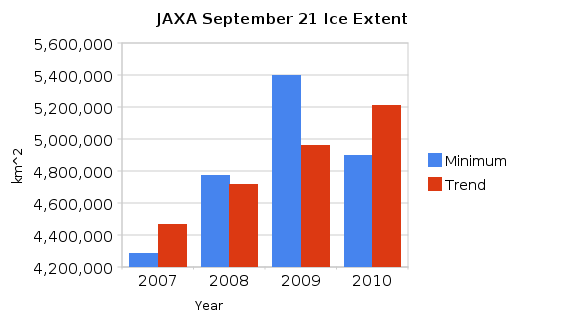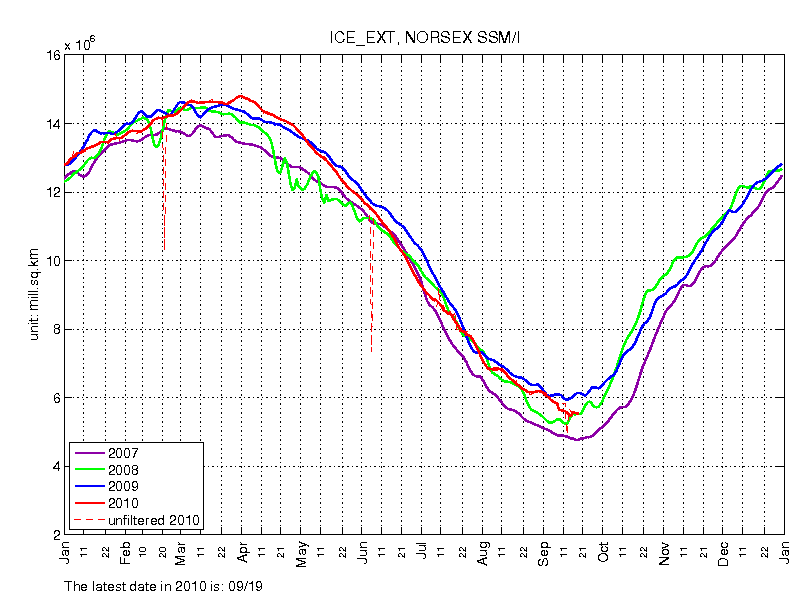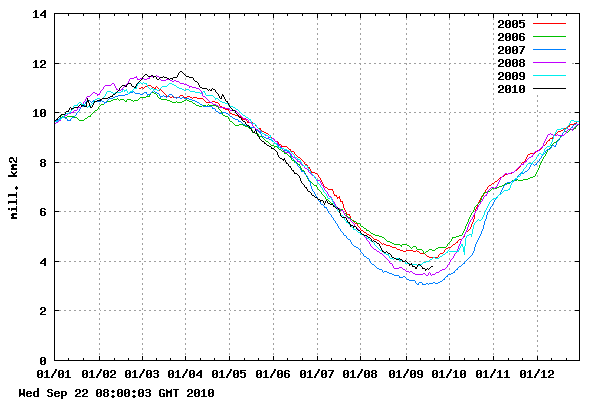September 21, 2007 was the day the earth stood still. Seven billion people breathlessly awaited the end of the winds which were compacting the Arctic ice. Everyone understood how the edge of the Arctic ice pack directly affected their ability to catch seals.
Since the “change point” in 2007, September 21 Arctic ice (15% concentration) extent has been expanding at a linear rate of 247,875 km² / year. Using the standard climate science metric, that is a gain of 4,201 Manhattans per year.
Norsex shows 2010 about 15% greater than 2007.
http://arctic-roos.org/observations/satellite-data/sea-ice/observation_images/ssmi_ice_ext.png
30% concentration ice has been expanding even faster, and is now about 25% higher than 2007.
http://ocean.dmi.dk/arctic/icecover.uk.php
The real test of “recovery” though is how thick and how old the ice will be in spring of 2011. Unless we have very strong winds pushing the older ice out of the Arctic this winter (as happened during the winter of 2007-2008) we should expect to see a large increase in thickness and the amount of multi-year ice, relative to spring 2008.





Next year’s minimum extent will be interesting. If it ends above 2009, it will be hard for the death spiralists to keep repeating their mantra. But if it grows too much, it will just be a sign of climate disruption 😉
It’s easy to see the growing trend since 20077. Even the NSIDC could argue there is a growing trend since then. But they don’t They argue there is still a trend of decrease happening. You can make statistics say anything.
The biggest problem, I think, in Arctic Ice data is that it covers such a short time period. If only we had a data set that went back 1000 years to the MWP. Then we see that all the alarm over 2007 is silly.
Amino, thanks to cores recovered on the Lomonosov ridge it appears that multiyear ice has been present to some extent in the Arctic for at least 14 million years (Moran, K., Backman, J. et al., 2006, The Cenozoic palaeoenvironment of the Arctic Ocean, Nature, Vol 441, 1 June 2006, doi:10.1038/nature04800.)
Julienne,
If there was plenty of ice during the MWP and earlier even warmer periods, does this not suggest that the Arctic is pretty robust and unlikely to melt away anytime soon?
Steve, I find the discussion of recovery interesting. Today there is only 100,000 sq-km of ice that is 5 years or older whereas in the 1980s there was 2 million sq-km of ice at least 5 years old at the end of summer. The distribution of ice in the Arctic has vastly changed these last 3 decades….
Julienne,
What was the distribution of ice like in the 1920’s + 1930’s?
Paul, unfortunately we didn’t have the same observational capabilities back then that we have today. Back in the 20s and 30s most of the assessments were based on eyeballing the ice (though some limited drilling was done). I talked with some guys from the Coast Guard today (they have been operating in the Arctic since 1865), and according to them there was a lot of thick, multiyear ice in the Arctic back then. Of course their assessment does not cover the entire Arctic Basin like we can observe today.
Julienne,
My understanding from published submarine data is that the early 1980s had anomalously high thickness. It makes sense after the cold 1960s and 1970s.
Didn’t most of the multi-year ice blow out of the Arctic during the winter of 2007-2008? It seems to be on the mend since then.
Steve, my understanding was a thinning between the 1950s and the 1990s based on submarine data published by Rothrock et al., 1999. But that was expressed in terms of change, so I’m not sure what 1980 was relative to the 1950s. (you can see a plot of thickness changes here: http://imb.crrel.usace.army.mil/change.htm).
there was some anomalous MYI lost during summer of 2007 out of Fram Strait, and certainly the positive AO state of the late 1980s/early 1990s also helped to remove old ice out of the Arctic basin, possibly setting up 2007 for such dramatic ice loss when the Dipole Anomaly became so strong and persistant. This winter, despite the negative AO, the ice transport out of Fram Strait was the same as the 1979-2009 climatology.
As expected, there was more MYI this spring than in 2008 and 2009 (but less than at the start of 2007 melt season), but in terms of the oldest ice (ice at least 5 years old, that has continued to decline since 2007).
Julienne,
Every year there is loss of 5+ year old ice. In order to maintain equilibrium, the amount lost and gained would have to average out to be the same. (Otherwise the Arctic would be full of very old, very thick ice.)
Given that all of the first year ice melted in 2007, isn’t it just a matter of mathematics that 2012 is the soonest when we could see an increase in 5+ ice?
wow, just wow. the absurdity at the start of this article is one of the most misleading graphs i have ever seen.
why not add in the 30 year average, which should be somewhere around 7 mio?
Tamino tells me it is OK to start a trend at a “change point” which is how GISS comes up with their bloated 2C/century global trend.
I’m just using the same rules. If you don’t agree with them, then let Tamino and Hansen know. ;^)
I know, it is OK for them to cherry pick, because they think they are the good guys.
At the end of the 2007 melt season there was about 16% of the FYI left over, so it didn’t quite all go away 😉
Until 1989 the amount of 5+ old ice exceeded 2 million sq-km. But then it dropped during the positive winter AO state of the late 1980s/early 1990s. Afterwards it bounced up and down somewhat, but more recently it has nearly all disappeared.
The main thing is that the old ice is no longer recirculating in the Arctic Basin like it once did.
I have never said all Arctic ice was gone during the MWP. I have said that it could have been gone. I also have said it is likely there was less ice in the Arctic during the MWP than now. And I still say that. I still also say that what happened in 2007 was part of natural variation. Until there is proof of anything otherwise I will continue to say it. Those who say it was unnatural are the ones needing to prove something.